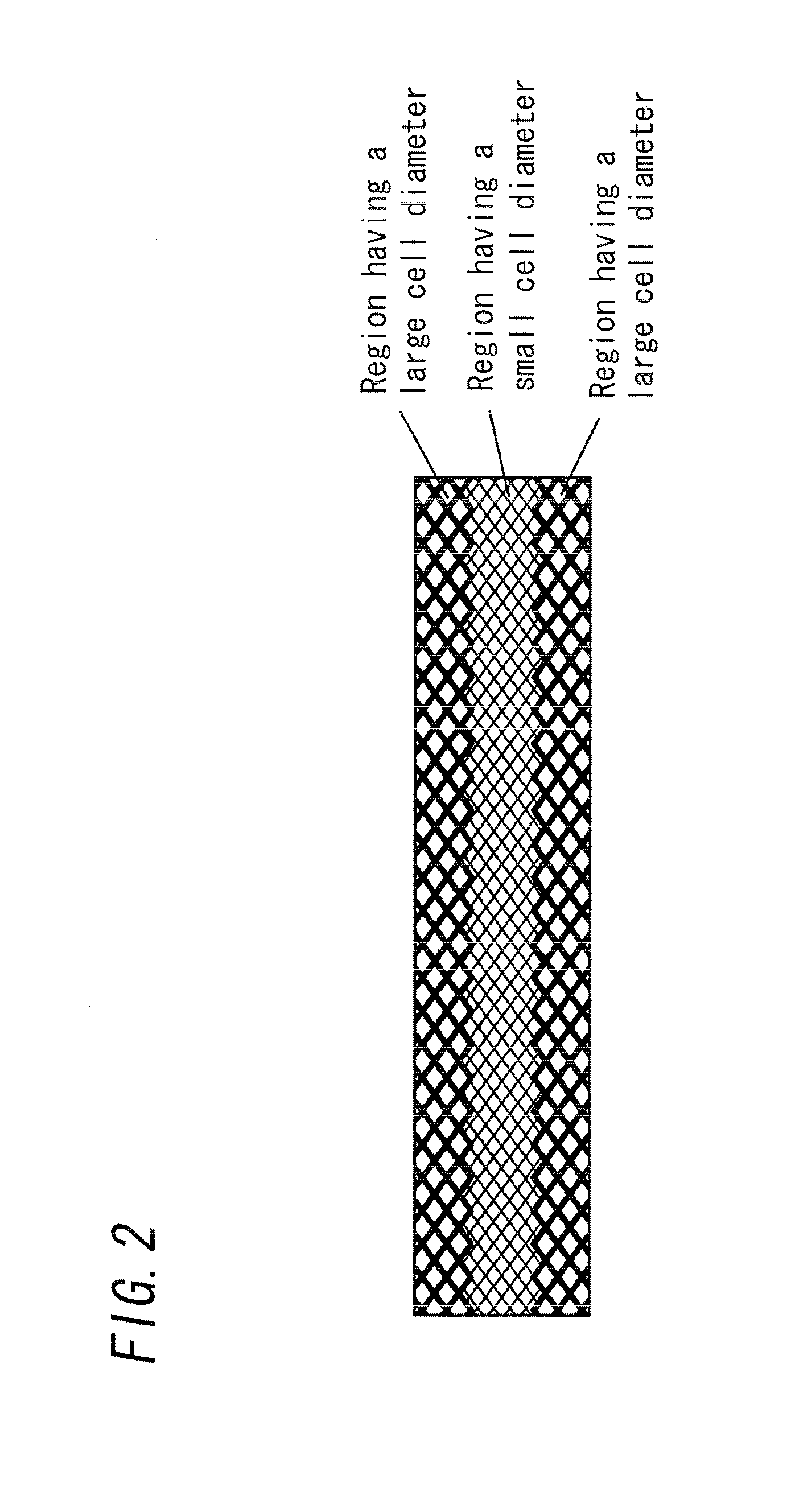Three-dimensional network aluminum porous body, electrode using the aluminum porous body, and nonaqueous electrolyte battery, capacitor and lithium-ion capacitor with nonaqueous electrolytic solution, each using the electrode
a network, aluminum technology, applied in the direction of electrolytic capacitors, cell components, transportation and packaging, etc., can solve the problems of difficult formation of a layer, low formation rate of aluminum layers, difficult to produce a large-area porous body, etc., to improve the current collecting performance of a central portion, improve the internal availability ratio of an active material, and reduce industrial production costs
- Summary
- Abstract
- Description
- Claims
- Application Information
AI Technical Summary
Benefits of technology
Problems solved by technology
Method used
Image
Examples
example 1
Formation of Conductive Layer
[0175]A urethane foam having a porosity of 95%, about 50 pores (cells) per inch, a pore diameter of about 550 μm, and a thickness of 1 mm was prepared as a resin molded body and was cut into a 100 mm×30 mm square. A film of aluminum was formed on the surface of the polyurethane foam in a weight per unit area of 10 g / m2 by the sputtering method to perform a conductive treatment.
[0176]As the above-mentioned resin molded body made of urethane, a resin molded body, which had been prepared by warming the top surface and the bottom surface of a mold to 60° C. in continuously foaming a polyurethane raw material for foaming in a sheet-shaped mold in a foaming step of the polyurethane.
(Molten Salt Plating)
[0177]The urethane foam having a conductive layer formed on the surface thereof was loaded as a piece of work in a jig having an electricity supply function, and then the jig was placed in a glove box, the interior of which was adjusted to an argon atmosphere an...
example 2
[0191]An aluminum porous body 2 was prepared in the same manner as in Example 1 except for using a urethane resin which was prepared by cooling the top surface and the bottom surface of the mold to 5° C. when the polyurethane raw material for foaming was continuously foamed in the sheet-shaped mold in the foaming step of the polyurethane, and had a thickness of 1.0 mm, a cell number of 50 per inch and a cell diameter of 550 μm.
[0192]A cross section of the obtained aluminum porous body 2 was observed in the same manner as in Example 1.
[0193]The results are as shown in Table 1, and the ratio of the reciprocal value of the number of aluminum skeletons in the region 1 to the reciprocal value of the number of aluminum skeletons in the region 2 was 0.84. Similarly, the ratio of the reciprocal value of the number of aluminum skeletons in the region 3 to the reciprocal value of that in the region 2 was 0.84.
example 3
[0194]An aluminum porous body 3 was prepared in the same manner as in Example 1 except for using a urethane resin which was prepared by warming the top surface of the mold to 60° C. and cooling the bottom surface of the mold to 5° C. when the polyurethane raw material for foaming was continuously foamed in the sheet-shaped mold in the foaming step of the polyurethane, and had a thickness of 1.0 mm, a cell number of 50 per inch and a cell diameter of 550 m.
[0195]A cross section of the obtained aluminum porous body 3 was observed in the same manner as in Example 1. A microphotograph was divided into two regions in the thickness direction of the porous body and one region was defined as a region 4 and the other region was defined as a region 5. Then, the reciprocal values of the number of aluminum skeletons in the regions 4 and 5 were measured in the same manner as in Example 1.
[0196]The results are as shown in Table 1, and the ratio of the reciprocal value of the number of aluminum sk...
PUM
| Property | Measurement | Unit |
|---|---|---|
| porosity | aaaaa | aaaaa |
| thickness | aaaaa | aaaaa |
| temperature | aaaaa | aaaaa |
Abstract
Description
Claims
Application Information
 Login to View More
Login to View More - R&D
- Intellectual Property
- Life Sciences
- Materials
- Tech Scout
- Unparalleled Data Quality
- Higher Quality Content
- 60% Fewer Hallucinations
Browse by: Latest US Patents, China's latest patents, Technical Efficacy Thesaurus, Application Domain, Technology Topic, Popular Technical Reports.
© 2025 PatSnap. All rights reserved.Legal|Privacy policy|Modern Slavery Act Transparency Statement|Sitemap|About US| Contact US: help@patsnap.com



